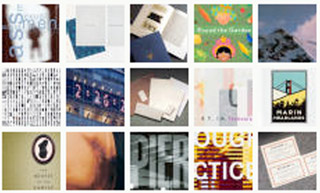|
Thursday, March 11th
‘We Choose the Moon’ chosen as Site of the Year
Perhaps the greatest voyage of exploration in history was reenacted in a manner befitting the Internet age for Apollo 11’s 40th anniversary in July last year. Sponsored by Boston’s JFK Presidential Library and Museum, ‘We Choose the Moon’ reenacts the Apollo 11 voyage, with animated videos, audios from the capcom, and all in real time. Along the way, pop-ups contain graphics and other information about the epic journey.
The recently redesigned Favourite Website Awards (FWA) site, already itself worthy of a least a few site-of-the-year awards, unsurprisingly made ‘We Choose the Moon’ its site of the day and month when it went live. Earlier this year it wasn’t a great surprise that, following more than 28 million site visits, it was also awarded with their coveted Site of the Year award for 2009.
This engrossing real-time recreation of the historic mission to the Moon complete with round-the-clock audio transmissions and 3D animations representing each step along the way and much more, was conceived, designed and developed by The Martin Agency and Domani Studios.
“We are especially thrilled for our friends at the JFK Presidential Library, our generous hosts at AOL, and the uncompromising talent at Domani Studios,” said Brian Williams of The Martin Agency. “We set out to honour JFK’s vision for our space effort, and to bring back to life a spirit of optimism from a bygone era.” On behalf of SOTY sponsor, Nokia, Arto Joensuu said the site is a great illustration of how well crafted digital work can allow us to immerse ourselves and relive an important moment in history.

Both informative and fun, the site uses Flash without being too flashy to recreate the tension and atmosphere of a defining moment in history. Although I’m old enough to have been able to enjoy following the mission on TV as it happened, experiencing this site 40 years on did much more than bring back memories. When the current economic woes are far enough behind us for another space mission of this scale to be considered, I hope I’ll still be around to follow it in real time on the Internet.
|
|
Friday, January 8th
A site to behold
The site I’m recommending you visit today is the stunning vehicle a couple of local interactive multimedia programmers and designers created to showcase their expertise and portfolio. Launched in September 2008, and soon thereafter receiving the prestigious FWA ‘site of the day’ award, Mark Barcinski and Adrien Jeanjean’s site is both a technological tour de force and a thing of beauty.

On the technology side, they built it in Flash with ActionScript 3.0, the Open Source real-time Papervision3D engine, VectorVision, an extension they developed for it that enables vector fonts to be rendered, and it uses anaglyphic 3-D navigation. On landing at the site, you’re given the choice of the full anaglyphic experience by putting on a pair of 3-D glasses, or viewing it normally. I didn’t have 3-D glasses, but it wouldn’t have made any difference in my case, since I don’t have stereoscopic vision either. As I’ve said, I still found the site a thing of beauty without the full 3-D effect, so if you have a pair, you’re in for a real treat.

Mark and Adrien have been together since 1999, when they both started as HTML freelancers at EuroRSCG Interactive in Amsterdam. They left to start their own studio five years ago, and founded the Barcinski & Jeanjean interactive studio in September 2007, which specializes in designing and creating interactive websites, art installations and other new media experiences.

The 360-degree panorama in which they stand with their portfolio suspended in the air around them was filmed in stop motion video on a bridge with views of the Prinsengracht and Reguliersgracht, a short walk from our office and an even shorter walk from theirs.

When you finally pull yourself away from the panorama photos to check out some of the portfolio, there’s much more to impress you. Recently-added projects include the design and development of a beautiful site for Wallzo, a design and art diection studio in London, and an amazing interactive installation they created enabling visitors to a restroom at an Amsterdam conference to contribute to a piece of music playing there .
|
|
Friday, November 27th, 2009
Ingenious use of Flash, without being flashy.

The American Institute of Graphic Arts (AIGA) is an association for communication design professionals. While we don't have design as an in-house skill - as you may have noticed from our site! - our work obviously involves regular collaboration with designers. It's always been a source of fascination and inspiration for me personally, and for some time I've enjoyed writing all kinds of material in English for the Dutch Design Awards, Lava Grafisch Ontwerpers, Design Academy Eindhoven, Studio Boot and others.

I'm recommending a visit to a site today for the designers among you or for those who share my collegial admiration for the craft. The AIGA's Design Archives site is an interactive record of their annual juried selections of design excellence and the work of designers they've honoured.

The AIGA archives represent an extensive collection of contemporary design for research and reference. It's been an expanding resource on American design, as each year's new selections and special collections are added. The latest annual selection, '(2009) 365: AIGA Year in Design 30', is a fascinating collection of design solutions divided over seven categories, from brand and identity systems design through information design to book design.

As you might expect, the archive site is itself an example of outstanding design, elegantly drawing the visitor through the various design categories. As you navigate deeper, the site allows you to view increasingly detailed descriptions of each of the entries and the designers behind them. A beautiful example of how Flash can be used to great effect, and without being 'flashy' or using illegibly small font sizes. Heartily recommended.
|
|
Tuesday, September 8th, 2009
Here’s to the next 10 years of ‘La Pompe’…

There have been a number of blogs and other sites for some time that have focused on exposing copy-cat ads, but the best-known and most talked-about is Joe La Pompe’s site. ‘Joe’ has been spotting remarkable ‘coincidences’ and possible or alleged plagiarism in ads for the last ten years. Here in Holland, Adformatie magazine regularly features examples from Joe’s site, and even had a ‘best of 2008’ spread at the beginning of this year.

Despite – or perhaps because of – his growing fame or, to some ‘creatives’, infamy, he has managed to maintain his anonymity. ‘Pompe’ is French for ‘sneaker’, as in shoe, but also has the meaning of ‘rip-off’, by the way. He has only revealed that he does work as a copywriter for an ad agency in Paris.

In a few interviews I’ve heard, he actually tends to be quite generous to those who produce what appear to be straight copies of others’ work, saying that he thinks it’s often a problem of young ad people who just don’t do enough research.

What’s inexcusable in my opinion is that so many campaigns that win prestigious awards around the world are amongst the worst examples. Even if some of them really are just ‘coincidences’, the judging panels should be experienced and diligent enough to check that the ideas they’re giving prizes to hadn’t been used before.

This is especially important given the silly obsession that many agencies – and, unfortunately, many of their major clients – have with these awards. ‘Joe’ was in Cannes again recently for the third consecutive year.

By all accounts the problem of multiply-reproduced ideas – sometimes even repeated three or four times – doesn’t show any sign of abating, despite how easy the Internet has made it to check that something the same or very similar hasn’t already been done.

The examples I’ve featured here are just a selection from the last few months from the growing archive on his site. I just find them both amusing and amazing, but imagine how you’d feel if you were the client who’d paid thousands for a copy-cat ad. I think Joe’s providing a valuable service for both agencies and clients, so here’s to the next ten years of ‘La Pompe’.
|
|
Friday, July 10th, 2009
A site that gives Web 2.0 radio a new twist

Neither amateur radio sites nor the ability to make your own radio show for the Internet are anything new. Sites like Live365 and SHOUTcast have been around for years, for example. It’s been particularly easy for some time for Mac users to make professional podcasts, that can essentially be a regular Internet radio show, and the latest versions of GarageBand and iWeb in iLife ’09 have made it easier still.
One of the issues that prospective broadcasters need to address if they want to produce a music show, or even just include published music, is copyright. Live365 takes care of the royalty issue by including the cost of their coverage in a range of monthly subscription packages. There are many other sites that leave the cost (or the inadvisable risk of not addressing the royalty issue) up to the broadcasters themselves.

After some months of trials by beta-testers, a group of Belgian entrepreneurs including Gilles Bindels and Cédric van Kan (above) launched the Beta version of Radionomy in April 2008. What was really original about this Web 2.0 site was that the founders believed they could make a commercial go of their project by making it easy for anyone to create, manage and broadcast their own Internet radio station, free of charge, and covering the copyright costs by sharing revenue from advertising with the creators when their audience reaches a certain size. Radionomy even provides libraries of music and jingles.
Last month, having secured substantial additional funding, Radionomy dropped their beta status and went fully public. It's a nicely designed site, and another plus for Internet radio listeners is that the content is refreshingly European. In fact they fovcus quite heavily on France, where they have a strong position. As of today they have 1,753 French, 253 English and 94 active Dutch radio shows. Some are very listenable, and as they're mostly music programming, language doesn't have to be a big issue. I can recommend you give Radionomy a visit, and I’ll certainly be returning again to see how the site develops.
|
|
Wednesday, May 6th, 2009
Category win and honour for Amsterdam agency in Webby Awards

In the 13th Webby Awards, announced yesterday, Amsterdam-based portable navigation device manufacturer TomTom won the ‘consumer electronics’ award for their innovative ‘Secret Services’ site. It’s basically an ongoing online campaign to explain the ‘secret’ functionalities of TomTom in-car navigation systems. It highlights a series of features people might not expect to find in a navigator and includes a number of engaging interactive components. Originally developed by local agency Black Magic Marker in 2007, the site was also awarded ‘best online campaign’ by the Internet Advertising Competition last year.
Black Magic Marker were also selected as an ‘Official Honoree’ in the ‘Cultural Institutions’ category for the site they produced for the Nationaal Comité 4 en 5 mei (Dutch institute for War Remembrance) and the Ministry of Health, Welfare and Sport. World War Two Online (wo2online.nl) was launched in March, and will feature changing ‘online exhibitions’ about various aspects of WW2 in the Netherlands, providing a trustworthy source about what really happened for a broad audience, from children learning about it for the first time to seniors remembering their childhood experiences.

Monday being Remembrance Day and yesterday Liberation Day made looking through the site this week particularly moving. The first ‘exhibition’ focuses on the first five days of the Nazi invasion. It starts in a living room at 3.55 in the morning of May 10, 1940 (above). While explosions and sirens are going off outside, you can listen to radio broadcasts from the time, read newspaper front pages and listen to eye-witness accounts. When you go outside, you see the Luftwaffe flying overhead and see German paratroopers dropping from the planes (below). The opening sequence is followed by an interactive map of the Netherlands with a day-by-day sequence of events detailing the invasion and beginning of the five-year occupation.

Having just worked on a newspaper industry outlook report for PricewaterhouseCoopers, which naturally focused on publishers competing with and moving into the online arena, it was interesting to see that the New York Times won Webby Awards for ‘best copywriting’ and ‘best practices’, the Guardian won ‘best newspaper’ and ‘best podcast’ – but no newspapers were even nominated for ‘best news’ award, which was won by the BBC News website. Meanwhile, the Boston Globe, whose owner, the NY Times, said on Monday this week that it would file a notice to close the prestigious New England paper if it fails to get unions to make further concessions, won the ‘best use of photography’ award for the ‘Big Picture’ section of its site.

One of my personal favourites was a site that won both the Webby Award and the ‘People’s Voice’ award for ‘best use of typography’. Jonathan Feinberg’s ‘Wordle’ is described as “a toy for generating ‘word clouds’ from text that you provide". The clouds give greater prominence to words that appear more frequently in the source text. You can tweak your clouds with different fonts, layouts, and colour schemes. The above is the result of my using the first two sentences from this site’s homepage. Because of the way it works, I guessed the result might have been more impressive had we been more repetitive, so I deliberately repeated a few words to generate the version below. Quite fun.

In the blogs area, marketing and branding consultant David Ibsen’s ‘Five Blogs Before Lunch’ won the ‘business blog’ award, while ‘1,000 Awesome Things’ won the ‘culture/personal’ blog. Launched a few months ago and updated every weekday, Neil Pasricha’s blog posted its 772nd ‘awesome thing’ today, which was ‘when you spill something on your shirt and it doesn’t leave a stain’. I do hate hearing young North Americans use ‘awesome’ all the time, but stopped short of making some condescending, deprecatory remark about their misuse of English just in time. I remembered being a typical kid in England in the early sixties, for whom the same things were ‘fabulous’. I’m sure it was equally annoying to adults at the time…
|
|
|
|





























